Health Assessment Document for Diesel Emissions - NSCEP | US ...
Health Assessment Document for Diesel Emissions - NSCEP | US ...
Health Assessment Document for Diesel Emissions - NSCEP | US ...
You also want an ePaper? Increase the reach of your titles
YUMPU automatically turns print PDFs into web optimized ePapers that Google loves.
1 In related studies, Navarro et al. ( 1981) evaluated the effect of exposure to diesel exhaust<br />
2 on rat hepatic and pulmonary microsomal enzyme activities. The same exposure regimen was<br />
3 employed (20 h/day, 5.5 days/week, <strong>for</strong> up to 1 year), and the exhaust was diluted to achieve<br />
4 concentrations of0.25 and 1.5 mg/m 3 DPM (a few studies were also conducted at 0.75 mg/m 3 ).<br />
5 After 8 weeks of exposure, there was no evidence <strong>for</strong> the induction of cytochrome P450,<br />
6 cytochrome P448, or NADPH-dependent cytochrome c reductase in rat liver microsomes. One<br />
7 year of exposure had little, if any, effect on the hepatic metabolism ofB[a]P. However, 1 year of<br />
8 exposure to 0.25 and 1.5 mg/m 3 significantly impaired the ability of lll\lg microsomes to<br />
9 metabolize B[a]P (0.15 and 0.02 nmole/30 min/mg protein, respectively, versus 0.32 nmole/30<br />
10 min/mg protein <strong>for</strong> the controls).<br />
11 There are conflicting results regarding the induction of microsomal AHH activities in the<br />
12 lungs and liver of rodents exposed to diesel exhaust. One study reported induced AHH activity<br />
13 in the lungs, liver, and prostate of rats exposed to diesel exhaust containing 6.32 mg/m 3 DPM <strong>for</strong><br />
14 20 h/day <strong>for</strong> 42 days; however, no induction of AHH was observed in the lungs ofrats and mice<br />
15 exposed to 6 mg/m 3 DPM <strong>for</strong> 8 h/day, 7 days/week <strong>for</strong> up to 8 moor to 0.25 to 2 mg/m 3 <strong>for</strong><br />
16 periods up to 2 years. Exposure to diesel exhaust has not been shown to produce adverse effects<br />
17 on microsomal cytochrome P450 in the lungs or liver of rats or mice. The weight of evidence<br />
18 suggests that the absence of enzyme induction in the rodent lung exposed to diesel exhaust is<br />
19 caused either by the unavailability of the adsorbed hydrocarbons or by their presence in<br />
20 insufficient quantities <strong>for</strong> enzyme induction.<br />
21<br />
22 5.1.2.3.10. Effects on behavior and neurophysiology. Studies on the effects of exposure to<br />
23 diesel exhaust on the behavior and neurophysiology of laboratory animals are summarized in<br />
24 Table 5-13. Laurie et al. (1978) and Laurie et al. (1980) examined behavioral alterations in adult<br />
25 and neonatal rats exposed to diesel exhaust. Exposure <strong>for</strong> 20 h/day, 7 days/week, <strong>for</strong> 6 weeks to<br />
26 exhaust containing 6 mg/m 3 DPM produced a significant reduction in adult spontaneous ioco-<br />
27 motor activity (SLA) and in neonatal pivoting (Laurie et al., 1978). In a follow-up study, Laurie<br />
28 et al. (1980) found that shorter exposure (8 h/day) to 6 Iilg/m 3 DPM also resulted in a reduction<br />
29 of SLA in adult rats. Laurie et al. (1980) conducted additional behavioral tests on adult rats<br />
30 exposed during their neonatal period. For two of three exposure situations (20 h/day <strong>for</strong> 17 days<br />
31 postparturition, or 8 h/day <strong>for</strong> the first 28 or 42 days postparturition), significantly lower SLA<br />
32 was observed in the majority of the tests conducted on the adults after week 5 of measurement.<br />
33 When compared with control rats, adult 15-month-old rats that had been exposed as neonates (20<br />
34 h/day <strong>for</strong> 17 days) also exhibited a significantly slower rate of acquisition of a bar-pressing task<br />
35 · to obtain food. The investigators noted that the evidence was insufficient to determine whether<br />
2/1/98 5-67 DRAFT--DO NOT CITE OR QUOTE















